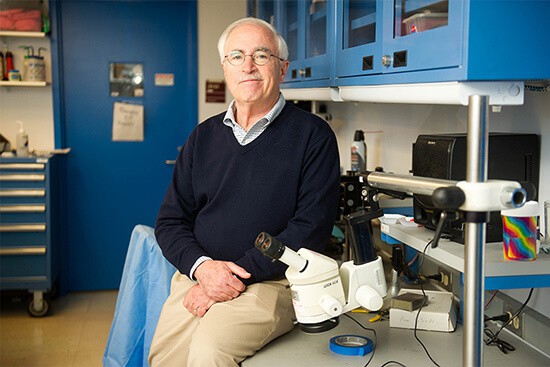You’ve got a plan to pick up groceries for dinner on the way home. Right now, though, you’re in your office, coffee in hand. A co-worker drops by asking what materials are needed for an upcoming meeting.
Your answer, most likely, isn’t “carrots.” That’s because the human brain contains circuitry that retrieves memories appropriate for the current situation.
New work from the lab of Howard Eichenbaum, Boston University William Fairfield Warren Distinguished Professor and director of BU’s Center for Memory & Brain, suggests that this circuitry spans long distances in the brain and supports a complex dialog between two brain structures. The work, published online in June in Nature Neuroscience, is among the first to describe the operations of a large brain circuit that controls complex behavior. By revealing the details of the communications between brain regions to access appropriate memories, the findings may give clinical researchers clues about which communication channels may be impaired in brain disorders that disrupt memory.
“Understanding this system has implications for almost any disorder that affects memory, from schizophrenia, depression, and epilepsy to traumatic brain injury and post-traumatic stress disorder,” says Charan Ranganath, a neuroscientist at the University of California, Davis, who studies human memory but was not involved in this research. “We’re really interested in understanding the ability to use knowledge to make decisions.”
Foraging for Froot Loops
To study a complex human behavior, such as remembering appropriate information at the right time, Eichenbaum had to train rats to memorize an important piece of information and then find a way for them to use it. So his team trained rats to find Froot Loops in flowerpots. “Rats are absolutely nuts about Froot Loops,” he says.
For example, the rats learned that in room A the cereal is hidden in a pot filled with purple plastic beads that smell sweet. But in room B, the goods are in the pot filled with black paper shreds that smell spicy. “Rats are great with odors and textures, so we’re using textural and olfactory cues to direct them to express their memory,” says Eichenbaum.
As the rats navigate from room to room, Eichenbaum’s team records their brain activity using electrodes inserted into the brain. They monitor both the hippocampus, known to be the seat of memory in the brain, and the prefrontal cortex, thought to be a coordinator.

The circuitry that guides the selection of memories based on the current context spans the rat brain. Information flows from the ventral hippocampus (vHPC), in the lower part of the brain, to the prefrontal cortex (mPFC), and then back to the dorsal hippocampus (dHPC), near the top of the brain. Breakdowns in the circuitry can cause different types of memory problems, including loss of memory and also the inability to determine which memories are appropriate for the current situation. Diagram courtesy of Howard Eichenbaum
In previous studies, the team had already learned that neurons in the prefrontal cortex fire in relation to cues that signal rewards, such as a particular pot that contains a stash of Froot Loops. They had also identified neurons in a region called the ventral hippocampus that recognize the room the rat is in. Neurons in the dorsal hippocampus fire when the rat recognizes a flowerpot it has seen before. In this most recent experiment, they learned how the brain puts these pieces of information together to guide a decision, like which pot to dig in.
For instance, when the rat enters room A, the ventral hippocampus transmits to the prefrontal cortex, setting the context to room A. The dorsal hippocampus begins firing as it recognizes flowerpots. The prefrontal cortex, which knows that the reward in room A is in the pot with purple beads, sends this information to the dorsal hippocampus, telling it which memory to act on. “The two regions operate together as a system, kind of like handshaking,” says Eichenbaum. “We’re seeing at the level of neurons what happens in cognitive life.”
Memory with Purpose
This handshaking is important because many things can go wrong to interrupt it. When Eichenbaum’s team temporarily disabled the prefrontal cortex, the rats foraged in every pot, not because they don’t recognize the pots but because they don’t know which pot contains a reward based on the room they are in. “The prefrontal cortex has a very specific role,” says Eichenbaum. “It doesn’t activate the right memories, but rather it prevents the wrong memories from intruding.”
This finding may be relevant to human diseases like schizophrenia. People with this disorder don’t have trouble remembering things but often have trouble filtering out irrelevant or inappropriate information. “If the hippocampus remembers something, it’s the sound of one hand clapping,” says Ranganath. “It doesn’t help you unless it reaches areas that can use the information to make a decision or action.”
There is no direct anatomical connection in the brain between the prefrontal cortex and dorsal hippocampus, so it isn’t clear how messages are passed between them. But Eichenbaum’s studies suggest that there may be an indirect, bidirectional route that involves slow, pulsing brain rhythms called theta rhythms. These rhythms originate in deep structures in the middle of the brain, synchronize between the hippocampus and the prefrontal cortex, and allow information to flow between them.
To explore this possibility, Eichenbaum is using optogenetics, a powerful tool that allows researchers to configure specific neurons in the brains of rats so that they can be turned on or off using laser light. “We hope to trace the whole pathway of the circuit that is crucial to this dialog,” says Eichenbaum.
Theta rhythms are an important clue for researchers like Ranganath, too. “We’ve got to study theta activity in the human brain now that we think it’s related to your ability to remember the things you need to remember when you need to remember them,” he says.


